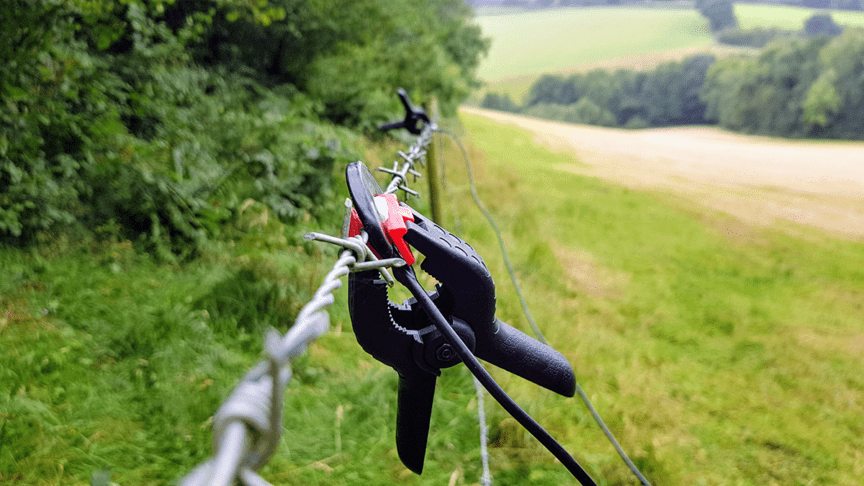I’ve owned a JRF C-Series contact mic since I began field recording. Many recordists spoke of their versatility. For £35 per mic, it seemed like a no-brainer. I did have early success with it, recording radio mast cables in Iceland. However, with little inspiration, the microphone has sat largely unused at the bottom of my recording bag.
The times that I did experiment, I found the results to be a little disappointing. The low-end was lacklustre, the midrange sounded hollow, and the top-end was hissy. I assumed that this was user-error. I imagined I was recording the wrong sources or using poor technique.
Only recently when I attended a workshop led by the JRF C-Series Pro maker, Jez Riley French was I reminded that in order to get the most out of contact mics, an impedance transformer should be used to convert the contact microphone impedance to match the recorder’s mic input impedance. Inspired by the workshop, I ordered another C-Series contact mic and two Hosa Technology MIT-129 Impedance Transformers.

What is an Impedance Transformer?
Most commercial microphones are Lo-Z, meaning they have a low impedance. As such, recording devices have inputs matched to receive low impedance signals. Contact mics however are based on piezo materials and are Hi-Z. The result is that upon reaching the recording device, the signal is “loaded down” and negatively altered.
The Hosa impedance transformer package states that using the MIT-129 will result in the following improvements:
- Maximisation of signal fidelity
- Minimisation of high frequency and level loss
- Elimination of noise and hum
On top of this, I was told that they would dramatically improve the mic’s bass response.
A/B Testing the Hosa MIT-129 using a JRF C-Series on barbed wire
For my first test I chose to record a barbed wire fence on a windy day. Contact mics need movement to capture sound. I prefer organic sources of vibration where possible for unpredictable results. Metal wire tends to excite a wide range of frequencies and normally contains some bass drone.
I positioned the contact mics next to one another, plugging one directly into my Mixpre 6 left input (TRS) and the other into the impedance transformer, before connecting it to the right input (XLR). I linked in the inputs to match the gain. The results can be heard in split mono below:

As you can hear, the difference between the recordings is immense. What jumps out are the enormous improvements in the low end. With the impedance transformer, the bass sounds full and extended, dominating the recording and giving it an almost cinematic sound. We can also hear huge improvements to the signal to noise ratio.
However, its interesting to note that in using the transformer we have actually lost rather than gained high frequencies. Whereas without the transformer, we can see some harmonics up and above 10kHz, with the transformer there is very little above 5kHz.
I then realised that using the unpowered impedance transformer inevitably results in level loss. This also explains the remarkable improvements to S/N ratio. To confirm this I decided to run a quick home test.
Testing high frequency loss

I attached the two mics in the same manner to a radiator. Only this time I unlinked the inputs and raised the gain on the right input until the noise floor of the two mics sounded roughly the same in my headphones. On my recorder this was an extra 12db of gain.
I ran a screwdriver along the length of the radiator and recorded the results:

Clearly with the extra gain the impedance transformer is able to capture the same high frequency content. My Mixpre 6 has powerful preamps, but with lower powered recorders such as handhelds, getting enough gain could be an issue with quieter sources.
One other improvement I noticed was that the transformer-less mic had an earthing buzz, presumably caused by the house’s electrics. This was not at all present with the transformer.
Conclusion

There’s no doubt that matching the impedance of your contact mic makes enormous improvements to the sound.
The gains to S/N ratio are decent, but what really excites me is the depth and of low frequency content that is accessed with a transformer. In some cases the bass response could be overbearing. It could even be necessary to apply a low frequency roll-off in order to capture the full frequency range without clipping. I was also able to confirm that that the converter removed hum, something that will be invaluable when recording near electricity circuits.
Its worth noting that these transformers are not optimised for contact mics. Even better results could be found with a converter that matches the specific resistances of the contact mic and recorder input. LOM instruments has a great list of converter options to explore and is highly recommended further reading.
My next step is to head out and explore new sound sources. I can recommend playgrounds as an amazing supplier of moving metal parts. Local kids (and sound recordists) in my area are even lucky enough to have access to a zip-line!
With the transformer attached you can really start thinking outside the box. I got amazing bass frequencies from the trunk of a giant oak tree swaying in the wind.
From now on I will follow the mantra that anything can be a source if you attach a contact mic to it!
Bonus recording – zip-line WITH impedance transformer


